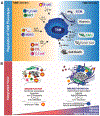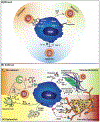Macrophages as regulators of tumour immunity and immunotherapy
- PMID: 30718830
- PMCID: PMC7339861
- DOI: 10.1038/s41577-019-0127-6
Macrophages as regulators of tumour immunity and immunotherapy
Abstract
Macrophages are critical mediators of tissue homeostasis, with tumours distorting this proclivity to stimulate proliferation, angiogenesis and metastasis. This had led to an interest in targeting macrophages in cancer, and preclinical studies have demonstrated efficacy across therapeutic modalities and tumour types. Much of the observed efficacy can be traced to the suppressive capacity of macrophages, driven by microenvironmental cues such as hypoxia and fibrosis. As a result, tumour macrophages display an ability to suppress T cell recruitment and function as well as to regulate other aspects of tumour immunity. With the increasing impact of cancer immunotherapy, macrophage targeting is now being evaluated in this context. Here, we discuss the results of clinical trials and the future of combinatorial immunotherapy.
Figures



References
Publication types
MeSH terms
Grants and funding
LinkOut - more resources
Full Text Sources
Other Literature Sources
Research Materials

